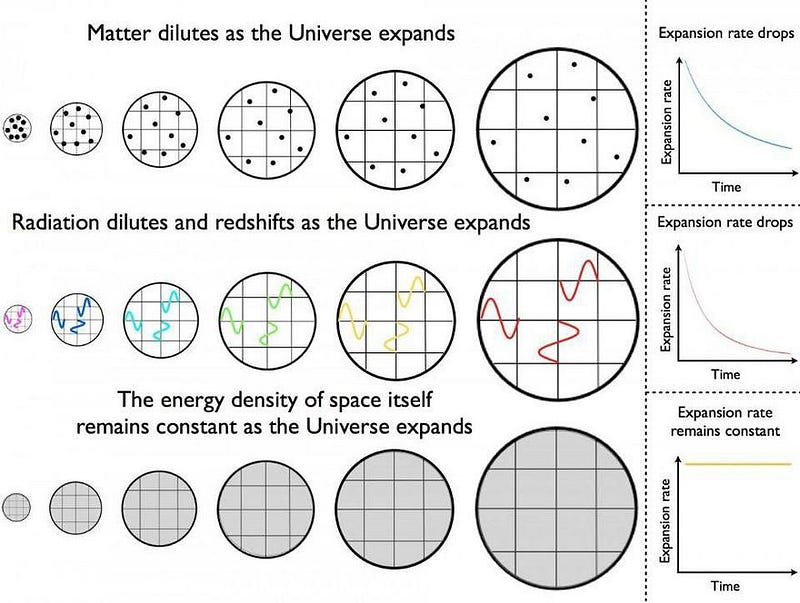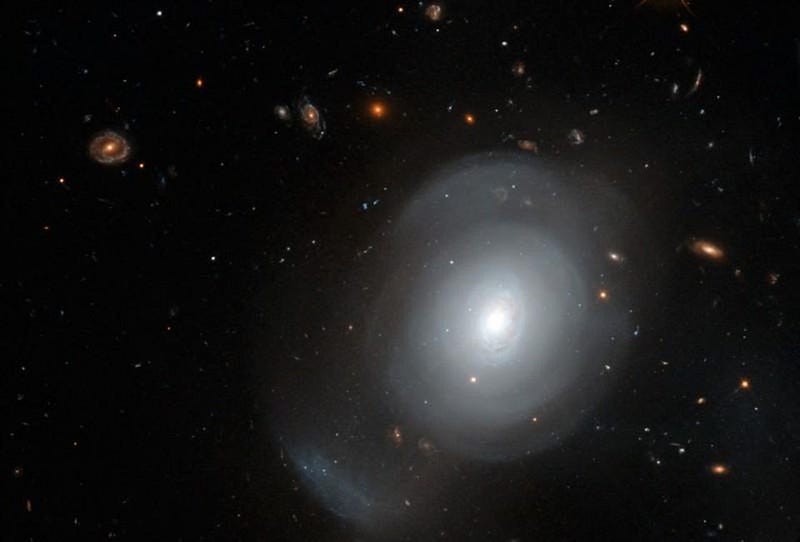Ask Ethan: Could The Universe Be Torn Apart In A Big Rip?

Dark energy is pushing distant galaxies apart from one another at an increasing rate. If the Big Rip hypothesis is true, things will only get worse from here.
One of the biggest surprises in all of physics came at the end of the 20th century: in 1998. By looking at some of the most distant events arising from a single star — type Ia supernovae — we were able to determine that the Universe wasn’t just expanding, but accelerating. There must be something more than just matter, radiation, and the curvature of space filling the Universe.
There needed to be a new form of energy that caused distant galaxies to accelerate away from us. This mysterious dark energy might be a cosmological constant, but it might be something more interesting. One interesting option could change the fate of the Universe, resulting in a Big Rip. That’s the subject of Patreon supporter Ken Blackman’s question, as he asks:
Is The Big Rip — where expansion exceeds all the other forces — still considered a possible future for our Universe? What are the arguments for or against? And if so, how would it unfold, what would happen?
Let’s find out.

When we look out at the distant Universe, we find that it’s full of light-emitting and absorbing sources. There are stars, galaxies, quasars, clusters of galaxies, and an enormous cosmic web of structure. There’s also dust, neutral gas, ionized plasma, dark matter, and enormous cosmic voids between the structures. There’s a wide variety of types of radiation; there are neutrinos, and there are black holes.
And if you add all that together, it makes up only one third of all the energy in the Universe. The “stuff” that gravitates the way we know it is a minority of what’s actually in the Universe.

We know this from how the Universe has expanded over its history. About 6 billion years ago, distant galaxies started to speed up in their recession away from us: the Universe was accelerating. Based on our observations of how they’re moving now, as well as observations of the cosmic microwave background, large-scale structure, and other indicators, we’ve determined that the Universe is 68% composed of dark energy.
This energy doesn’t appear to drop in density as the Universe expands, unlike matter and radiation. Whereas matter becomes less dense as the volume of the Universe increases, and radiation also redshifts to longer, less energetic wavelengths, dark energy is an energy inherent to space itself. As new space is created, the energy density remains constant.

This allows us, in theory, to predict the fate of the Universe. If dark energy were truly a constant type of energy that didn’t change as the Universe expanded, the Universe would simply expand forever. The Hubble rate of expansion would asymptote to a constant, finite value of approximately 55 km/s/Mpc. As distant galaxies grew more and more distant, from 10 Mpc to 100 Mpc to 1 Gpc, the recession speed would rise to 550 km/s, 5,500 km/s, and then 55,000 km/s.
Unlike in a scenario where there wasn’t any dark energy, the Universe is accelerating. As far as our observations indicate, it will continue to accelerate at this constant rate arbitrarily far into the future. The fate of the Universe should be cold, empty, and lonely; only the objects that are already gravitationally bound today will remain within reach of one another.

This assumes, however, that dark energy is truly a cosmological constant. It assumes that it doesn’t increase or decrease in strength or density, that it doesn’t change sign, and that it doesn’t vary across space. We have good evidence that this is the case, mostly from observations of how galaxies cluster on the largest scales.
But even with the best observations that we have, we cannot be certain that dark energy is a cosmological constant. It could vary with time somewhat substantially, increasing or decreasing by no more than a certain amount. The way we quantify how much dark energy can vary is with a parameter called w, where if w = -1 exactly, it’s a cosmological constant. But observationally, w = -1.00 ± 0.08 or so. We have every reason to believe its value is -1, exactly.

If dark energy isn’t a constant, there are two major possibilities for how it could change. If w becomes more positive over time, then dark energy will lose strength, and potentially even reverse its sign. If this is the case, the Universe will stop accelerating and the expansion rate will drop to zero. If its sign reverses, the Universe may even recollapse, fated for a Big Crunch.
There is no good evidence that indicates this will be the case, but next-generation telescopes like the LSST, WFIRST, and EUCLID should be able to measure w down to an accuracy of 1–2%, a vast improvement over what we presently have. These observatories should all come online in the 2020s, with EUCLID scheduled to get there first: launching in 2021.
Of course, there’s always the option that w becomes more negative over time, dipping below -1 and remaining there. If this is the case, something fascinating happens: the Universe experiences a fate known as the Big Rip.

If dark energy is truly constant, than things like our Solar System, our galaxy, and even our local group of galaxies — consisting of the Milky Way, Andromeda, the Triangulum Galaxy, the Magellanic Clouds and a few dozen small, dwarf galaxies — will remain gravitationally bound together for trillions upon trillions of years into the future.
But if dark energy is increasing in strength, which it will do if w< -1, then that acceleration rate will not only drive distant galaxies away from us, but will cause these large-scale structures to become gravitationally unbound as time goes on!

Dark energy will get stronger and stronger over time, and this will have dire consequences for the fate of everything that makes up our Universe today.
When the energy density of dark energy increases to about ten times what it is today, it will be enough to prevent the Milky Way from merging with Andromeda. Instead, this “Big Rip” scenario will drive our neighboring galaxy away from us, like all the other distant galaxies in the Universe. Also gone would be the Triangulum Galaxy and most of the other dwarf galaxies as well. But this won’t be the end; dark energy will continue to increase in strength.
Increase the energy density of dark energy to about a hundred times its current value, and the stars on the Milky Way’s outskirts will begin flying off from our galaxy. The metric expansion of space will be able to overcome even the gravitational pull of all the matter in our local neighborhood, both normal and dark.
And if you increase dark energy’s strength to two or three hundred times its present value, our Sun will join those outer stars in being torn apart from our galaxy. Our Solar System will fly through intergalactic space all by its lonesome.

But this won’t be the end of what we’ll lose in a Big Rip scenario. The energy density of dark energy will continue to rise, and eventually, this will threaten the existence of not just our Solar System, but every Solar System in the Universe. When dark energy becomes strong enough, the planets themselves will become unbound from our Sun.
The Oort cloud will go first, followed by the scattered disk and the Kuiper belt, and then Neptune, Uranus, Saturn, and Jupiter. The asteroids would go next, followed by Mars. Earth will get thrown out of orbit when dark energy reaches a density that’s 100 billion times its present value.
And finally, here on Earth, the ultimate catastrophe would befall anyone left behind. Humans would be separated from Earth’s gravitational pull, individual cells, molecules, atoms, and nuclei would be torn apart, as the dark energy density continued to increase to an infinite amount. Presumably, even the fundamental fabric of spacetime itself would be torn apart at the very end.

Thankfully, with the constraints we have on dark energy today, that w = -1.00 ± 0.08, we have time. If the Universe will end in a Big Rip, that’s a fate that won’t befall us until 80 billion years from now at the earliest: nearly six times the present age of the Universe. The unbinding of galaxies from one another, the very first notable step on the path to a Big Rip, won’t occur for many tens of billions of years even in the most pessimistic viable scenario.
To the best of our knowledge, there isn’t any robust data that favors dark energy increasing in strength versus remaining constant, but we have to get more sensitive to know for sure. What is certain, however, is that no matter what the evidence indicates, we’ll measure it better than ever before as the 2020s unfolds, with the Earth, Sun, galaxy, and local group all safe from this fate for many generations of stars to come. The Big Rip, although not ruled out, at least lies a very long time in the future.
Send in your Ask Ethan questions to startswithabang at gmail dot com!
Ethan Siegel is the author of Beyond the Galaxy and Treknology. You can pre-order his third book, currently in development: the Encyclopaedia Cosmologica.




